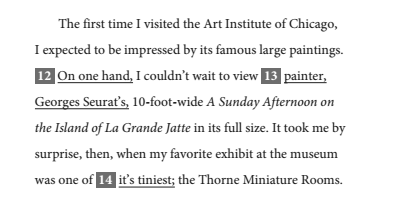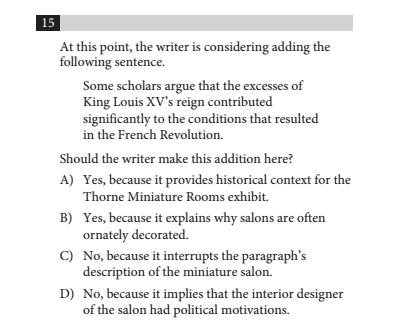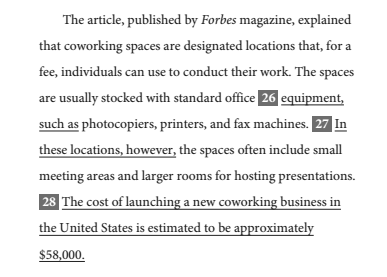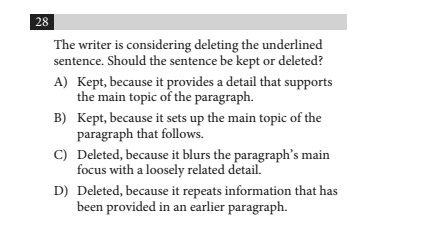
Add/Delete questions require you to determine whether a sentence should be added or deleted from a passage. There are multiple add/delete questions on SAT Writing, so figuring out how to tackle these questions is imperative to improving your Writing score.
In this post, I'll do the following:
- Explain add/delete questions
- Teach you the basic constructions of add/delete questions
- Provide example questions
- Give you strategies and a step-by-step approach for answering these questions
Add/Delete on SAT Writing
Add/Delete questions ask you if a sentence should be added or deleted from a specific part of a passage. Typically, these questions involve two parts: you have to determine if the sentence should be added or deleted, and you’ll also have to select why the sentence should be added or deleted. These questions require reading comprehension and understanding how a sentence fits within a passage. Generally, there are about 2-4 add/delete questions on the SAT Writing section.
General Construction of Add/Delete Questions
Being able to identify an add/delete question will help you determine how to quickly and efficiently select the right answer. Here are the general constructions for the add/delete questions you’ll find on SAT Writing.
Add Questions
This is the general construction of an add question:
At this point, the writer is considering adding the following sentence.
[Question Sentence Here]
Should the writer make this addition here?
A. Yes, because…
B. Yes, because…
C. No, because…
D. No, because…
You have to determine if the sentence should be added and identify the reason why it should or shouldn’t be added.
Delete Questions
Here is how delete questions are constructed:
The writer is considering deleting the underlined sentence. Should the writer do this?
A. Yes, because…
B. Yes, because…
C. No, because…
D. No, because…
Or you might see a delete question posed like this:
The writer is considering deleting the underlined sentence. Should the sentence be kept or deleted?
A. Kept, because
B. Kept, because
C. Deleted, because
D. Deleted, because
For delete questions, you have to determine if the underlined sentence makes sense at that point in the passage. Both questions are asking the same thing, but the wording of the questions is slightly different. Also, pay attention to the answer choices. In the first type, you choose answer choice A or B if the sentence should be deleted. In the second type, you choose choice C or D if the sentence should be deleted. Always read the question and answers carefully.

Now we know how add/delete questions are constructed.
Step-by-Step Guide to Add/Delete Questions
Here are the steps to follow to answer add and delete questions.
Add Questions
These are the first two paragraphs of a passage and an add question from a practice SAT.



#1: Analyze the Added Sentence to See What It’s Doing
The sentence is pretty straightforward. It’s stating that some scholars believe that the lavishness of the lifestyles during the reign of King Louis XV helped bring about the conditions that caused the French Revolution.
#2: Refer Back to the Passage to See if the Sentence Should Be Added Given Where It Would Be Placed
The added sentence must be relevant in context. It must logically follow previous sentences and set up the information that comes after it. While the previous sentence references King Louis XV, the passage up to that point is about an exhibit showing tiny rooms. The following sentences are a description of the miniature salon. The sentence in question wouldn’t make sense because the focus of the paragraph is on the appearance of the room and has nothing to do with whether or not the excesses of the era caused the French Revolution.
#3: Answer the Yes or No Question First
Because the sentence wouldn’t logically fit in the context of the passage, we can determine that the answer is no.#4: Eliminate the Two “Yes” or “No” Answer Choices
Because the answer is no, we can immediately eliminate A and B.#5: Provide the Reasoning in Your Own Words
In my own words, I would say that the sentence shouldn’t be added because the paragraph is focusing on the appearance of the room.
#6: Pick the Answer Choice That Most Closely Matches Your Reasoning
Answer choice D is wrong because there is no mention of the interior designer. Again, the focus is on what the room looks like. The correct answer is C. It most closely matches our reasoning. Adding the irrelevant sentence would disrupt the description of the miniature salon.

Delete Questions
Next, I'll walk you through how to answer a delete question. The steps are very similar to those of the add questions.



#1: Determine the Purpose of the Deleted Sentence
The sentence is providing the cost of starting a new coworking business in the US.
#2: Refer Back to the Passage to Determine if the Sentence Should Be Deleted Based on Its Location in the Passage
In our example, we have to determine if providing the cost of starting a coworking business is relevant to the focus of the passage. The passage is describing coworking spaces. Nowhere else is there information about starting a coworking business.
If you’re not reading closely, you may see the word “fee” in the first sentence, and then assume that that’s related to the underlined sentence. However, the first sentence just mentions that you can use coworking spaces for a fee; it has nothing to do with starting a coworking business. Again, the focus is on the traits and qualities of coworking spaces.
#3: Answer the Kept or Deleted Question First
Because the sentence is irrelevant to the focus of the paragraph, the sentence should be deleted.
#4: Eliminate the Two Kept or Deleted Answer Choices
Because the sentence should be deleted, we can eliminate choices A and B.
#5: Provide the Reasoning in Your Own Words
I would say that the sentence should be deleted because the cost of starting a coworking business isn’t related to the paragraph’s focus of describing coworking spaces.
#6: Select the Answer Choice That Most Closely Matches Your Reasoning
While I didn’t provide the previous paragraph, there’s no mention of the cost of starting a coworking business in that paragraph. We can eliminate answer choice D. The correct answer is C. The sentence isn’t related to the paragraph’s main focus.

Sean MacEntee/Flickr
Quick Review: General Strategies
Here’s advice to follow when answering all add/delete questions.
#1: Determine the Purpose or Summarize the Sentence That Would Be Added or Deleted
In order to decide whether to add or delete a sentence, you need to know what the sentence means and why it would be included in the passage.
#2: Refer Back to the Passage to Determine If the Added or Deleted Sentence Logically Fits
Any added sentence should logically follow the previous sentence and connect to the following sentence. Additionally, an added sentence must be relevant to the focus of the paragraph or passage. A sentence should be deleted if it falls outside the scope of the passage or doesn’t logically connect to the previous and following sentences.
#3: Answer the First Part First
Answer the “yes” or “no” question or “kept” or “deleted” question first.
#4: Eliminate Wrong Answer Choices
You can immediately eliminate the two answer choices that don’t match your answer to the first part of the question. If it's an add question and you think the sentence should be added, you can get rid of the answer choices that state the sentence shouldn't be added. Or if you think the sentence shouldn't be added, you can get rid of the two answer choices that claim the sentence should be added.
#5: Select the Answer Choice That Most Clearly Matches Your Reasoning
For all add/delete questions, before selecting an answer, determine in your own words why a sentence should be added or deleted. Ideally, you’ll see an answer choice that’s almost identical to your reasoning. If there’s no answer that matches your reasoning, work backwards to select the correct answer. Start with the answer choice and then determine if it's accurate. Or, if time permits, review the question/passage again to make sure you didn't make a mistake.
What's Next?
As you're preparing to become an SAT Writing superstar, make sure you thoroughly understand the most important grammar rules on SAT Writing.
Also, if you're not yet familiar with the most recent changes to the SAT, find out about what's different and how to prepare for the new SAT Writing.
Finally, learn how diligence and the proper methods can help you get a perfect SAT score.











